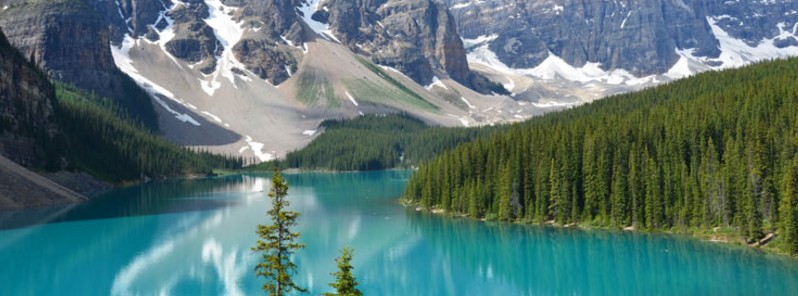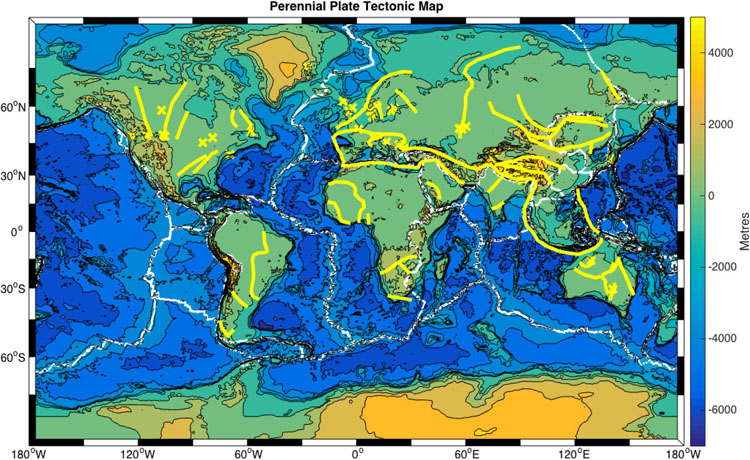Research suggests major changes to geology textbooks

A new research of the Earth’s crust and upper-mantle suggests that ancient geologic events may have left deep ‘scars’ that can come to life to play a role in earthquakes, mountain formation, and other ongoing processes on our planet.
This changes the widespread view that only interactions at the boundaries between continent-sized tectonic plates could be responsible for such events.
A team of researchers from the University of Toronto and the University of Aberdeen used super-computers to create models that indicate that former plate boundaries may stay hidden deep beneath the Earth’s surface. These multi-million-year-old structures, situated at sites away from existing plate boundaries, may trigger changes in the structure and properties at the surface in the interior regions of continents.
“This is a potentially major revision to the fundamental idea of plate tectonics,” says lead author Philip Heron, a postdoctoral fellow in Russell Pysklywec’s research group in U of T’s department of Earth sciences.
A new map of Earth’s ancient geology
Heron and Pysklywec, together with University of Aberdeen geologist Randell Stephenson have even proposed a ‘perennial plate tectonic map’ of the Earth to help illustrate how ancient processes may have present-day implications.
“It’s based on the familiar global tectonic map that is taught starting in elementary school,” says Pysklywec, who is also chair of U of T’s department of Earth sciences. “What our models redefine and show on the map are dormant, hidden, ancient plate boundaries that could also be enduring or “perennial” sites of past and active plate tectonic activity.”
To demonstrate the dominating effects that anomalies below the Earth’s crust can have on shallow geological features, the researchers used U of T’s SciNet – home to Canada’s most powerful computer and one of the most powerful in the world – to make numerical models of the crust and upper-mantle into which they could introduce these scar-like anomalies.

A proposed perennial plate tectonic map. Present-day plate boundaries (white lines), with hidden ancient plate boundaries that may reactivate to control plate tectonics (yellow lines). Image credit: Russell Pysklywec, Philip Heron, Randell Stephenson.
Simulating yesterday’s continents
The team essentially created an evolving “virtual Earth” to explore how such geodynamic models develop under different conditions.
“For these sorts of simulations, you need to go to a pretty high-resolution to understand what’s going on beneath the surface,” says Heron. “We modeled 1 500 kilometers across and 600 kilometers deep, but some parts of these structures could be just two or three kilometers wide. It is important to accurately resolve the smaller-scale stresses and strains.”
Using these models, the team found that different parts of the mantle below the Earth’s crust may control the folding, breaking, or flowing of the Earth’s crust within plates — in the form of mountain-building and seismic activity – when under compression.
In this way, the mantle structures dominate over shallower structures in the crust that had previously been seen as the main cause of such deformation within plates.
“The mantle is like the thermal engine of the planet and the crust is an eggshell above,” says Pysklywec. “We’re looking at the enigmatic and largely unexplored realm in the Earth where these two regions meet.”
An Earth in hibernation
“Most of the really big plate tectonic activity happens on the plate boundaries, like when India rammed into Asia to create the Himalayas or how the Atlantic opened to split North America from Europe,” says Heron. “But there are lots of things we couldn’t explain, like seismic activity and mountain-building away from plate boundaries in continent interiors.”
The research team believes their simulations show that these mantle anomalies are generated through ancient plate tectonic processes, such as the closing of ancient oceans, and can remain hidden at sites away from normal plate boundaries until reactivation generates tectonic folding, breaking, or flowing in plate interiors.
“Future exploration of what lies in the mantle beneath the crust may lead to further such discoveries on how our planet works, generating a greater understanding of how the past may affect our geologic future,” says Heron.
The research carries on the legacy of J. Tuzo Wilson, also a U of T scientist, and a legendary figure in geosciences who pioneered the idea of plate tectonics in the 1960’s.
“Plate tectonics is really the cornerstone of all geoscience,” says Pysklywec. “Ultimately, this information could even lead to ways to help better predict how and when earthquakes happen. It’s a key building block.”
Source: University of Toronto
Reference:
- “Lasting mantle scars lead to perennial plate tectonics” – Philip J. Heron, Russell N. Pysklywec & Randell Stephenson – Nature Communications, June 10, 2016 – doi:10.1038/ncomms11834 – OPEN ACCESS
Featured image: Moraine Lake at Banff National Park. Credit: Russell Pyslkywec

Commenting rules and guidelines
We value the thoughts and opinions of our readers and welcome healthy discussions on our website. In order to maintain a respectful and positive community, we ask that all commenters follow these rules:
We reserve the right to remove any comments that violate these rules. By commenting on our website, you agree to abide by these guidelines. Thank you for helping to create a positive and welcoming environment for all.